Choose your driving or flying style: gas power engine (GP) or electric power motor (EP)! |
| For uncomplicated and relaxing fun, nothing beats electric powered models which use an electric motor (EP = Electric Powered) as the driving or flying power source. Nickel-Cadmium (Ni-Cd) or Nickel-Hydride rechargeable batteries are the original source of the models powerful movement. This exhilarating force can be simply switched ON, or OFF. EP models are also quiet with less restrictions on where you can operate (within a safe environment). |
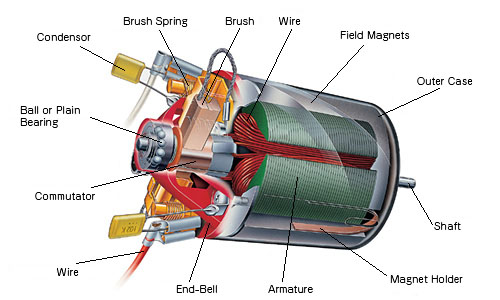 |
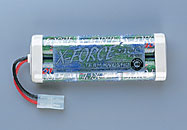 《Battery》 《Battery》The motor’s power comes from a rechargeable Ni-Cd or Nickel Hydride battery. Each model has a specified voltage and capacity (indicated by mAh), and may require a certain shape or size battery. A battery with the same voltage but higher capacity will spin the motor for longer times. 《Battery Charger》 AC type battery chargers plug into 100V wall sockets, while DC type battery chargers connect to a 12V car battery. DC type chargers are designed for quick battery charging and reduce waiting time, plus can be charged as many times as you like from your car at the track, lake or flying field. Some chargers are intended for only one type of battery, so choose a charger that corresponds to your batteries specifications. |
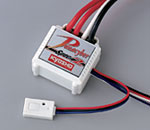 《Speed Controller》 《Speed Controller》Controls the speed the motor rotates at. Depending on the performance of the speed controller, differences in power output and running time may occur. (EP Ultima ST, RB Blizzard EV and EP boats except the EP Air Streak 500, all include a speed controller).  《Optional Motors》 《Optional Motors》There are many types of electric motors with various power characteristics. Choose a motor type with the performance characteristics that best meet the demands of your model. |
|
| Model engines work on exactly the same theories as full-sized engines, and create the same exciting sound and power as well. As with full-sized engines, model engines are available in 2 cycle, 4 cycle and rotary types, and produce the atmosphere that EP models cannot. Engine (GP = Gas Power) models use an alcohol based fuel for glow engines. Other than at ignition, it is not necessary to heat the glow plug, so the engine is lightweight and delivers the power easily for optimum R/C model performance. |
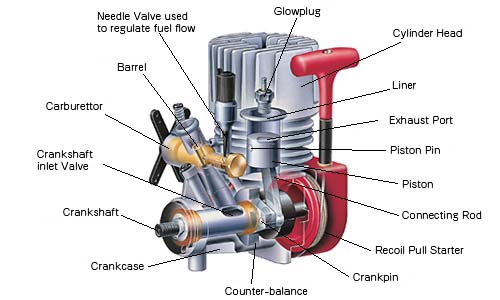 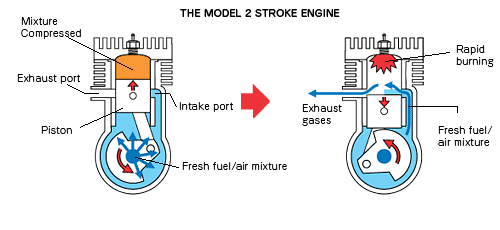 |
| 《Fuel》 As the piston rises and compresses the fuel/air mixture in the combustion chamber, the glow plug heats red and ignites the fuel and combustion occurs. The repetition of this cycle is the main characteristic of the glow engine. As the glow plug ignites automatically under compression during the cycle, no mechanism to govern ignition timing or spark generation is required as they are on a full sized gasoline engine. Glow fuel is designed with those characteristics. The quality of the fuel used has a large bearing on the power output from the engine. The Kyosho fuels shown in this catalogue combine the correct ingredients to deliver the best running or flight performance. For confidence in fuel performance, these fuels are recommended. 《Glow Plug and Heater, Booster Cable》 As mentioned elsewhere, glow plugs are a critical component of glow engines. For best performance, use a glow plug specified for your engine. When starting the engine, 1.2V - 1.5V of current is required to heat the glow plug. For this this reason, an electric power source and a booster cable attached to the plug are needed. Once the plug is heated, turning the crank shaft should start the engine. On most Kyosho GP model, the engines are fitted with a recoil starter so pulling on the cord will turn the crank to start the engine. After the engine has started and engine rotation is stable, the engine will continue to run even when the booster cords on the glow plug are disconnected. |
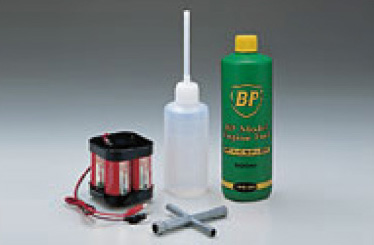 《Engine Starting Equipment》 Fuel bottle to fill the tank can also be used to get fuel into the carburettor, and a plug wrench needed for attaching/removing glow plug and locking the crank shaft, are required. |
|
| 《Engine Capacity》 Specific types of engines are available for each model category such as cars, airplanes and helicopters. Each model requires a specified engine capacity to meet its power source specifications. Below is a list of engine size names (usually its capacity in cubic inches) and their cubic centimetre capacity. As model engines were pioneered in Europe and America, the names of engine sizes have remained in cubic inches.Name Capacity in cc |
||